We Can't Go Back
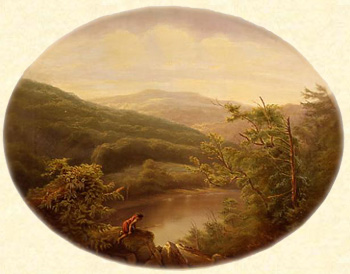
Probably every vegetarian who defends animals has heard--more than once--a counter-argument in the form of a defense of primal people's hunting practices. Unlike our own decadent times, goes the complaint, in prehistoric times people were close to nature. They surrounded the hunt with prayers and ceremonies, killed with reverence, thanked the spirit of the animal for its sacrifice, and used every part of the body. The problem, clearly, is not in human beings killing of animals for food but our alienation from nature, our lack of respect for the animal and the natural cycle of life consuming life. One writer, who venerates primal hunters, in defending his occasional killing of chickens for his table, claims that his actions are not violence so long as he maintains the appropriately reverential frame of mind. He did not say whether the chickens showed any sign of agreeing with him.
One seldom hears a word against primal peoples these days. This is of course partly because of a sense of inherited cultural guilt at the European colonists' wanton destruction of Native American cultures, which were in most cases sustainable as ours is not. The point that our society is alienated from nature can hardly be denied; in fact we are evidently on a collision course with it, and are likely come out second best if we come out at all. We must make peace with nature without delay. But it does not follow that the hunting practices of primal people are the solution to what ails us and the animals we kill and eat. There are profound problems with these activities, particularly with the hunting of large, powerful animals, problems not only for the victimized animals but for the hunters and their entire societies, problems that have descended to us from far prehistory and still bedevil us today.
Big-game hunting with neolithic weapons is a male activity, usually requiring teamwork, physical strength, physical courage, endurance, and aggressiveness, with suppression of sensitivity and compassion: in short, the qualities of machismo. In contrast to the low-key nature of gathering, which (most anthropologists now hold) was for millennia in the hands of women and which in most cases provided the mainstay of primal diets, the hunt brought drama--suspense, anxiety, triumph, and power. Jim Mason in An Unnatural Order suggests that males may have initiated the Great Hunt not only because of plant food shortages brought about by climatic and other changes, but also to enhance their uncertain status in a group in which women had hitherto held the prestige of bringing forth life and sustaining it. Whatever the reasons, one of the effects of the Great Hunt was that in developing the qualities necessary to take the spiritual power of large and strong animals, men also gained psychological and physical power over the group. Women, like the physically and psychologically weaker men who could not compete, lost their status, and came to be dominated and held in contempt.
As bands increased in size and became tribes, with increased physical needs, the aggressiveness of controlling males, and their cult of the hunt, would tend to expand into the cult of warfare. The gratifications of dominance over large animals, and over women, are expanded by victory over neighboring tribes. (The feelings of the defeated tribes, like those of the dying chicken, can be ignored.) No doubt the situation was complex, varying considerably in different times and places over the enormous stretch of prehistory, with causality working both ways.
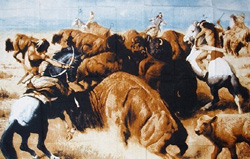 Clearly the situation of primal hunters, with its violence, its deep
alienations between the sexes and between peoples, is far from being
the paradise that contemporary romanticization of primal peoples
usually portrays. Yet it evidently co-existed, to varying degrees,
for a very long time with an embeddedness in and deep respect and awe
regarding nature. It took the further steps of herding and the
discovery of agriculture, to begin to establish an outlook of
dominance over nature which diminished the awe and oneness of
gathering-hunting peoples.
Clearly the situation of primal hunters, with its violence, its deep
alienations between the sexes and between peoples, is far from being
the paradise that contemporary romanticization of primal peoples
usually portrays. Yet it evidently co-existed, to varying degrees,
for a very long time with an embeddedness in and deep respect and awe
regarding nature. It took the further steps of herding and the
discovery of agriculture, to begin to establish an outlook of
dominance over nature which diminished the awe and oneness of
gathering-hunting peoples.
Many important factors which cannot be explored here went into the process of bringing about our present state of dangerous alienation from nature, alienation that threatens global catastrophe. To this situation present-day herding practices are major contributors, with their animal concentration camps that devour almost half the world's grain, consume a huge portion of dwindling water resources, and pollute much they do not consume. We can agree with the romanticizers that this system is a monster which must go. But we who are inspired by a vision of true Peace among sentient beings, who see the divine in the eyes of an animal, know that hunting, however reverential, always contains the seeds of Might-Makes-Right.
It is not the answer. We cannot go back to the past.

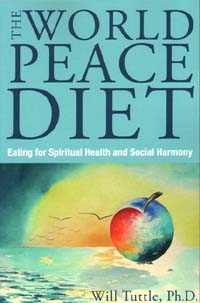 There is an elephant in the living room, says Will Tuttle. Much
energy is expended in numbing ourselves to ignore this open secret,
the violent exploitation of farmed animals that underlies our meals.
In a parallel image, our culture is like a dysfunctional family with
dark, agonizing secrets that are taboo to discuss, secrets which
must be brought into the light if the family is to find healing.
There is an elephant in the living room, says Will Tuttle. Much
energy is expended in numbing ourselves to ignore this open secret,
the violent exploitation of farmed animals that underlies our meals.
In a parallel image, our culture is like a dysfunctional family with
dark, agonizing secrets that are taboo to discuss, secrets which
must be brought into the light if the family is to find healing.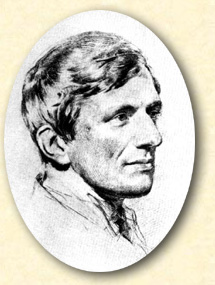 You will observe that our Lord is called a Lamb in the text; that is, He was as defenceless and as innocent as a lamb is. Since then Scripture compares Him to this inoffensive and unprotected animal; we may without presumption or irreverence take the image as a means of conveying to our minds those teachings which our Lord’s sufferings should excite in us. I mean, how horrible it is to read the account which sometimes meet us of cruelties exercised on animals.
You will observe that our Lord is called a Lamb in the text; that is, He was as defenceless and as innocent as a lamb is. Since then Scripture compares Him to this inoffensive and unprotected animal; we may without presumption or irreverence take the image as a means of conveying to our minds those teachings which our Lord’s sufferings should excite in us. I mean, how horrible it is to read the account which sometimes meet us of cruelties exercised on animals.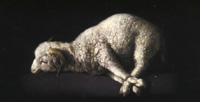 I do not like to go into particulars, for many reasons, but one of those instances which we read as happening in this day and which seems more shocking than the rest is when the poor dumb victim is fastened against a wall, pierced, gashed and so left to linger out its life. Now do you not see that I have reason for saying this, and am not using these distressing cases for nothing? For what was this but the very cruelty inflicted upon our Lord? He was gashed with the scourge, pierced through hands and feet and so fastened to the Cross, and there left, and that as a spectacle. Now what is it that moves our very hearts and sickens us so much as cruelty shown to poor animals? I suppose this first, that they have done no harm; next that they have no power whatsoever of resistance; it is the cowardice and tyranny of which they are the victims which make their sufferings so especially touching. For instance, if they were dangerous animals, take the case of wild animals at large; much as we might dislike to hear of their wounds and agony, yet our feelings would be of a very different kind.
I do not like to go into particulars, for many reasons, but one of those instances which we read as happening in this day and which seems more shocking than the rest is when the poor dumb victim is fastened against a wall, pierced, gashed and so left to linger out its life. Now do you not see that I have reason for saying this, and am not using these distressing cases for nothing? For what was this but the very cruelty inflicted upon our Lord? He was gashed with the scourge, pierced through hands and feet and so fastened to the Cross, and there left, and that as a spectacle. Now what is it that moves our very hearts and sickens us so much as cruelty shown to poor animals? I suppose this first, that they have done no harm; next that they have no power whatsoever of resistance; it is the cowardice and tyranny of which they are the victims which make their sufferings so especially touching. For instance, if they were dangerous animals, take the case of wild animals at large; much as we might dislike to hear of their wounds and agony, yet our feelings would be of a very different kind.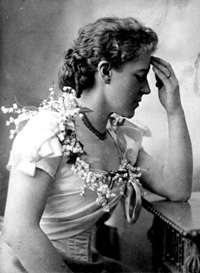 So many gods, so many creeds,
So many gods, so many creeds,